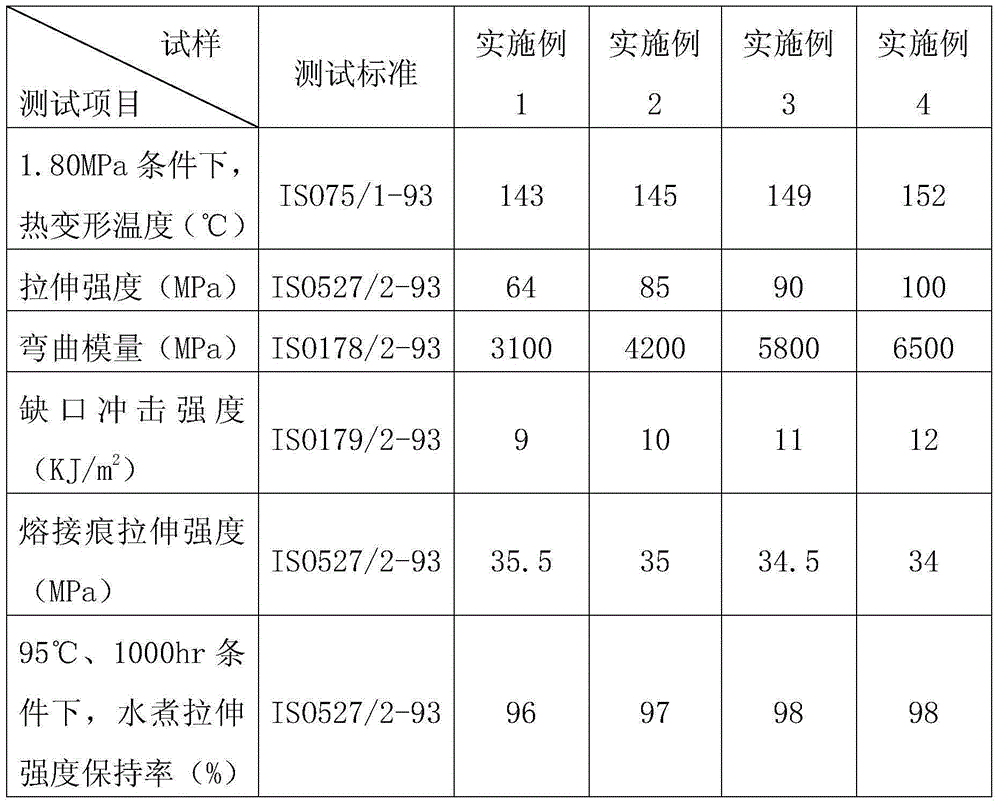Hydrolysis-resistant glass fiber reinforced polypropylene composite material for automobile kettle and its preparation process
A composite material and polypropylene technology, which is applied in the field of hydrolysis-resistant glass fiber reinforced polypropylene composite materials for automobile water bottles and its preparation technology, can solve the problem of poor welding performance and hydrolytic stability, which cannot meet the further requirements of automobile water bottles, and cannot meet Requirements for car kettle materials and other issues, to achieve the effect of overcoming insufficient heat resistance, excellent heat resistance, and preventing extraction
- Summary
- Abstract
- Description
- Claims
- Application Information
AI Technical Summary
Problems solved by technology
Method used
Image
Examples
Embodiment 1
[0021] In this embodiment, the hydrolysis-resistant glass fiber reinforced polypropylene composite material for automobile kettles is prepared as follows:
[0022] Firstly, 85 parts of polypropylene PPT30S, 0.2 parts of phenolic heat stabilizer 1790, 0.3 parts of phosphite heat stabilizer 627A, 0.3 parts of auxiliary EBS, 0.2 parts of nucleating agent TMP-5, 2 parts of metallocene polypropylene elastic Body VM6202, 2 parts of maleic anhydride grafted polypropylene CA-100 are put into a twin-screw extruder with a length-to-diameter ratio of 40:1 for melt mixing and dispersion;
[0023] Then 10 parts of alkali-free chopped glass fiber 305K is accurately fed into the twin-screw extruder through a loss-in-weight metering scale from the side feeding; finally, it is extruded and pelletized by the twin-screw extruder at 210°C to obtain The hydrolysis-resistant glass fiber reinforced polypropylene composite material for the car kettle.
Embodiment 2
[0025] In this embodiment, the hydrolysis-resistant glass fiber reinforced polypropylene composite material for automobile kettles is prepared as follows:
[0026] First, 70 parts of polypropylene PPS700, 0.5 parts of phenolic heat stabilizer 1790, 0.5 parts of phosphite heat stabilizer 627A, 0.5 parts of auxiliary EB-FF, 0.5 parts of nucleating agent HPN-20E, 3 parts of metallocene polymer Propylene elastomer VM6102, 5 parts of maleic anhydride grafted polypropylene 1001CN are put into a twin-screw extruder with a length-to-diameter ratio of 40:1 for melt mixing and dispersion;
[0027] Then 20 parts of alkali-free chopped glass fiber 508A is accurately fed into the twin-screw extruder through a loss-in-weight metering scale from the side feeding; finally, it is extruded and pelletized by the twin-screw extruder at 220°C to obtain The hydrolysis-resistant glass fiber reinforced polypropylene composite material for the car kettle.
Embodiment 3
[0029] In this embodiment, the hydrolysis-resistant glass fiber reinforced polypropylene composite material for automobile kettles is prepared as follows:
[0030] First, 60.5 parts of polypropylene PPS900, 0.7 parts of phenolic heat stabilizer 1790, 0.8 parts of thioester heat stabilizer 412S, 1 part of auxiliary EB-FF, 1 part of nucleating agent 3988, 4 parts of metallocene polypropylene elastic Body VM3980, 7 parts of maleic anhydride grafted polypropylene 1001 were put into a twin-screw extruder with a length-to-diameter ratio of 40:1 for melt mixing and dispersion;
[0031] Then 25 parts of alkali-free chopped glass fiber 248A is accurately fed into the twin-screw extruder through a loss-in-weight metering scale from the side feeding; finally, it is extruded and pelletized by the twin-screw extruder at 230°C to obtain The hydrolysis-resistant glass fiber reinforced polypropylene composite material for the car kettle.
PUM
| Property | Measurement | Unit |
|---|---|---|
| melt flow index | aaaaa | aaaaa |
| melt flow index | aaaaa | aaaaa |
| tensile strength | aaaaa | aaaaa |
Abstract
Description
Claims
Application Information
 Login to View More
Login to View More - R&D
- Intellectual Property
- Life Sciences
- Materials
- Tech Scout
- Unparalleled Data Quality
- Higher Quality Content
- 60% Fewer Hallucinations
Browse by: Latest US Patents, China's latest patents, Technical Efficacy Thesaurus, Application Domain, Technology Topic, Popular Technical Reports.
© 2025 PatSnap. All rights reserved.Legal|Privacy policy|Modern Slavery Act Transparency Statement|Sitemap|About US| Contact US: help@patsnap.com

